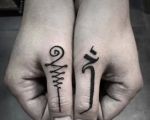
Tips for Choosing the Right Tattoo That Tells Your Personal Story
I still remember the moment I decided I wanted my first tattoo. It wasn’t a random decision—something deep inside me longed to express a chapter of my life in a permanent way. Like many people, I wanted more than just ink. I wanted a piece of me etched into my skin, something meaningful and real. Choosing the right tattoo wasn’t easy, but what I learned along the way changed how I viewed body art forever.
1. Understand Your Motivation
What Story Are You Telling?
Before you even think about the design or placement, take time to understand your “why.” Are you commemorating a lost loved one? Celebrating survival after a tough period in your life? Or maybe it's about marking a joyful milestone. When I got my second tattoo—a small compass on my wrist—it wasn’t about travel. It symbolized finding my direction after years of feeling lost. The meaning behind a tattoo gives it life, not just the design.
Think Long-Term
Your tattoo will be with you forever, so ask yourself: Will this still be relevant to me 10, 20, or 30 years from now? I’ve seen friends get spontaneous tattoos during college and regret them later. But those who truly thought through their motivations still wear their ink proudly.
2. Research and Inspiration
Start with a Journal
I always recommend keeping a tattoo journal. Whenever an idea, word, symbol, or emotion resonates with you, write it down. Doodle. Collect visuals. One friend of mine created a vision board with clippings from magazines, art books, and even song lyrics. It helped her refine her concept into a design that was deeply personal.
Explore Different Cultures and Styles
Look into tattoo styles—traditional American, black and grey realism, watercolor, geometric, or tribal. Each style carries its own aesthetic and cultural significance. My Polynesian friend, for instance, chose a tatau design to honor his Samoan heritage. Learning about these backgrounds can not only inspire you but help you find something truly unique to you.
3. Choose the Right Artist
Don't Rush the Process
I cannot stress this enough: your tattoo artist is just as important as the design. Spend time reviewing portfolios. Look at healed tattoos, not just fresh ones. The difference matters. When I was searching for the right artist, I visited studios, asked questions, and even scheduled consultations just to talk. It made all the difference in the final result.
Seek Specialists for Unique Styles
Every tattoo artist has a specialty. If your idea involves intricate linework or watercolor shading, choose someone who excels in that area. I once made the mistake of picking an artist based on price rather than skill. Thankfully it was a small piece—but it taught me to value craftsmanship over cost.
4. Design and Symbolism
Less Is Sometimes More
In our eagerness to “say everything,” we sometimes overcrowd a design. Start simple. Focus on key symbols or elements that truly matter. For example, I have a friend who tattooed a single feather to represent freedom and healing—two powerful chapters of her life story. It’s understated, yet emotionally charged.
Personal Symbols Over Trends
Trends fade, but your story doesn’t. Think about icons or motifs that have followed you throughout life—animals, elements, numbers, or even colors. I once met a client who tattooed a paper plane on her ankle. At first glance it seemed random, but to her, it represented childhood dreams she was finally chasing. That’s the kind of symbolism that lasts.
5. Placement and Pain Considerations
Body Placement Tells a Story Too
Where you place your tattoo also matters. A chest piece may signify something close to the heart. A back tattoo could represent protection or a hidden truth. My arm tattoos are like visible reminders of my journey—seen every day, worn with pride. Choose a spot that matches the emotional weight of your story.
Know Your Pain Tolerance
Let’s be real—tattoos hurt. Some areas like ribs, feet, or the spine are more painful than others. If you're new to ink, maybe start with a less sensitive area. A client once told me she passed out during her first rib tattoo and had to come back in sessions. Pain is part of the process, but preparation makes it manageable.
6. Emotional Preparation
Tattooing Can Be Therapeutic
Getting a tattoo isn’t just physical—it’s emotional. I’ve had people cry during their session, not from pain, but from release. You’re literally turning emotion into art. If your tattoo is tied to a painful memory, be prepared to feel it again—but also to heal from it. That’s the beauty of this form of expression.
Share or Keep It Private
Some tattoos spark conversation. Others are meant for you alone. It’s okay to keep your story private, even when your tattoo is visible. I have one design that no one understands but me, and that’s exactly how I want it. Decide what you’re comfortable sharing and honor your boundaries.
7. Aftercare and Long-Term Commitment
Treat It Like an Investment
Once your tattoo is done, the real work begins—aftercare. Use fragrance-free lotion, keep it clean, and follow your artist’s advice. Poor aftercare can ruin even the best tattoo. I’ve learned to treat mine like an investment: sunscreen, moisture, and the occasional touch-up go a long way.
Living With Your Ink
Living with a tattoo is a daily experience. It becomes part of your reflection, your photos, your conversations. Make sure it’s a story you’re proud to carry. When I catch a glimpse of mine in the mirror, I feel grounded. They remind me of who I was—and who I’ve become.
Choosing the right tattoo isn’t about perfection—it’s about authenticity. If you’re on this journey, I hope you find the design that speaks your truth. And if you're unsure, take your time. The best tattoos are the ones that feel like home on your skin.
If you're looking for guidance or the perfect artist to bring your vision to life, I recommend checking out the team at Inked Up Dolls. They specialize in helping people like you turn emotion into art, story into ink.








